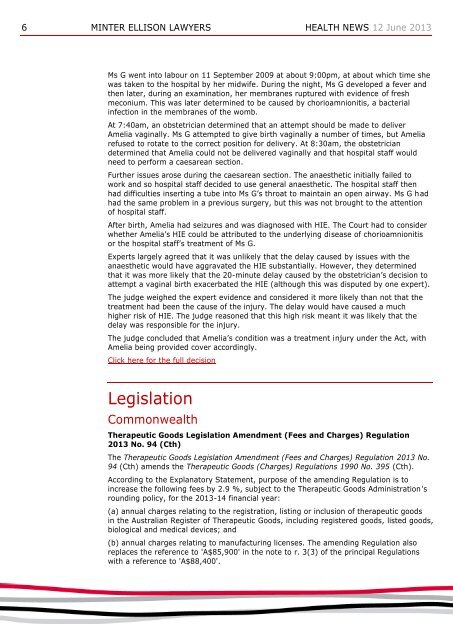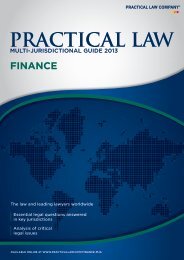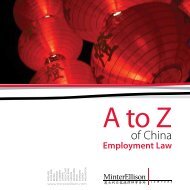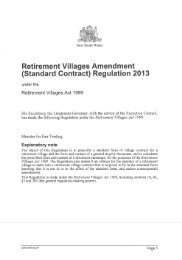Minter Ellison Health News 12 June 2013
Minter Ellison Health News 12 June 2013
Minter Ellison Health News 12 June 2013
You also want an ePaper? Increase the reach of your titles
YUMPU automatically turns print PDFs into web optimized ePapers that Google loves.
6 MINTER ELLISON LAWYERS HEALTH NEWS <strong>12</strong> <strong>June</strong> <strong>2013</strong><br />
Ms G went into labour on 11 September 2009 at about 9:00pm, at about which time she<br />
was taken to the hospital by her midwife. During the night, Ms G developed a fever and<br />
then later, during an examination, her membranes ruptured with evidence of fresh<br />
meconium. This was later determined to be caused by chorioamnionitis, a bacterial<br />
infection in the membranes of the womb.<br />
At 7:40am, an obstetrician determined that an attempt should be made to deliver<br />
Amelia vaginally. Ms G attempted to give birth vaginally a number of times, but Amelia<br />
refused to rotate to the correct position for delivery. At 8:30am, the obstetrician<br />
determined that Amelia could not be delivered vaginally and that hospital staff would<br />
need to perform a caesarean section.<br />
Further issues arose during the caesarean section. The anaesthetic initially failed to<br />
work and so hospital staff decided to use general anaesthetic. The hospital staff then<br />
had difficulties inserting a tube into Ms G’s throat to maintain an open airway. Ms G had<br />
had the same problem in a previous surgery, but this was not brought to the attention<br />
of hospital staff.<br />
After birth, Amelia had seizures and was diagnosed with HIE. The Court had to consider<br />
whether Amelia’s HIE could be attributed to the underlying disease of chorioamnionitis<br />
or the hospital staff’s treatment of Ms G.<br />
Experts largely agreed that it was unlikely that the delay caused by issues with the<br />
anaesthetic would have aggravated the HIE substantially. However, they determined<br />
that it was more likely that the 20-minute delay caused by the obstetrician’s decision to<br />
attempt a vaginal birth exacerbated the HIE (although this was disputed by one expert).<br />
The judge weighed the expert evidence and considered it more likely than not that the<br />
treatment had been the cause of the injury. The delay would have caused a much<br />
higher risk of HIE. The judge reasoned that this high risk meant it was likely that the<br />
delay was responsible for the injury.<br />
The judge concluded that Amelia’s condition was a treatment injury under the Act, with<br />
Amelia being provided cover accordingly.<br />
Click here for the full decision<br />
Legislation<br />
Commonwealth<br />
Therapeutic Goods Legislation Amendment (Fees and Charges) Regulation<br />
<strong>2013</strong> No. 94 (Cth)<br />
The Therapeutic Goods Legislation Amendment (Fees and Charges) Regulation <strong>2013</strong> No.<br />
94 (Cth) amends the Therapeutic Goods (Charges) Regulations 1990 No. 395 (Cth).<br />
According to the Explanatory Statement, purpose of the amending Regulation is to<br />
increase the following fees by 2.9 %, subject to the Therapeutic Goods Administration's<br />
rounding policy, for the <strong>2013</strong>-14 financial year:<br />
(a) annual charges relating to the registration, listing or inclusion of therapeutic goods<br />
in the Australian Register of Therapeutic Goods, including registered goods, listed goods,<br />
biological and medical devices; and<br />
(b) annual charges relating to manufacturing licenses. The amending Regulation also<br />
replaces the reference to 'A$85,900' in the note to r. 3(3) of the principal Regulations<br />
with a reference to 'A$88,400'.











